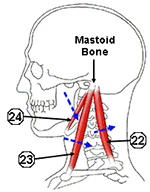Tension in the  suboccipital muscles can produce four different types of headaches. Each type of headache is caused by the direct contact of the suboccipitals with a nerve. suboccipital muscles can produce four different types of headaches. Each type of headache is caused by the direct contact of the suboccipitals with a nerve.
Frontal and Cluster Headaches
A frontal headache, marked by pain in the forehead, occurs when Rectus Capitis Posterior Major (18), one of the key muscles in the suboccipital group, irritates Obliquus Capitis Superior (17), located behind the ear. When 17 impinges on the lesser occipital nerve (B) it irritates the frontal sinus, making it swell, and causing a frontal headache.
This can also develop into a "cluster" headache over the eye, which is even more painful than a migraine headache. When the occipital nerve has been chronically impinged over a long period of time, the pain is usually numbed by endorphins. However, as the frontal sinus swells, it begins to press against and distort the forehead bones, frequently causing one eyeball to be lower than the other.
Maxillary Pain
When the 3rd occipital nerve (C) is irritated by Semispinalis Capitis (3) near the base of the skull, the nerve irritates the lining of the maxillary sinuses located between the eye socket and the upper teeth. This causes pain in the jaw, cheekbone, and upper teeth. But since most people have large enough openings in their maxillary sinuses to keep them from swelling shut, maxillary headache is a fairly rare phenomenon. and the upper teeth. This causes pain in the jaw, cheekbone, and upper teeth. But since most people have large enough openings in their maxillary sinuses to keep them from swelling shut, maxillary headache is a fairly rare phenomenon.
Migraine Headache
A migraine headache produces severe pain, often on one side of the head. It is sometimes accompanied by nausea and vomiting. Migraines occur when the suboccipital muscles irritate the greater occipital nerve (A) and lesser occipital nerve (B). These nerves then cause irritation and swelling in the spenoid and frontal sinuses. The sphenoid sinus produces the warning symptoms of visual flashes, nausea, and vomiting. The frontal sinuses create pain in the temples by pressing into the jaw muscles there.
Tension Headache
Tension headache is pain at the base of the skull. When you have a tension headache, you are feeling the occipital nerves themselves, at the point where a muscle is touching them.
|

